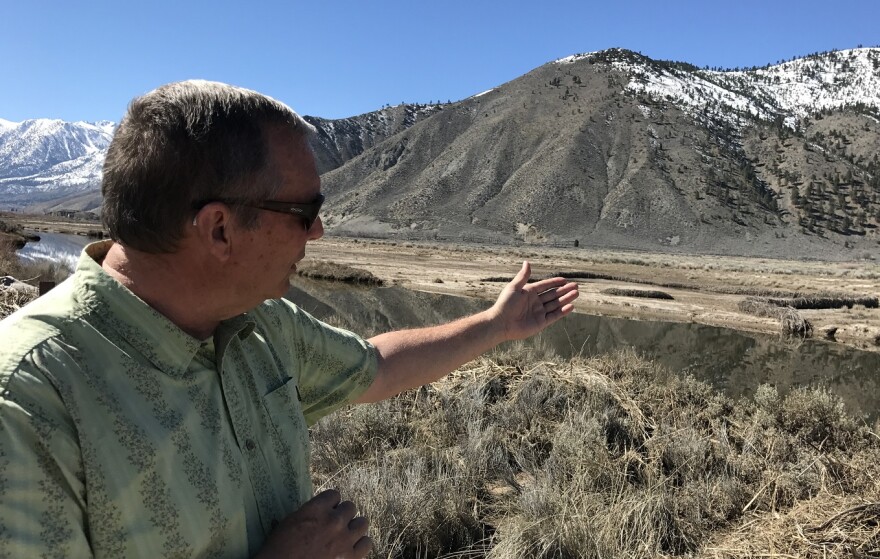This year, Northern Nevada was blasted with several major winter storms that caused widespread flooding and extensive property damage. But the weather also provided the first real test for area flood mitigation projects.
Reno Public Radio’s Noah Glick examines some of those efforts to see what the future of flood prevention might look like in the greater Truckee Meadows.
“This is the Mustang Ranch property. So this is owned by Bureau of Land Management. The old Mustang Ranch brothel sat in that grove of trees over there just on the other side of the road.”

Mickey Hazelwood walks down to the banks of the lower Truckee River east of Sparks, pointing out sections that have changed over the years.
“This is a constructed river channel,” he says. “I think after a few years of sorting itself out, pretty hard to tell that anybody was here, that anybody made any changes to this. It looks pretty natural.”
He’s the Truckee River Project director for The Nature Conservancy, a national non-profit focused on wildlife habitat protection and restoration. And in this case, flood mitigation.
To do that, he and his team essentially have to reverse the impact of human engineering that created deeper and broader channels in the Truckee, a practice that began in the 1960s.
“The prevailing thought at the time in engineering circles was that if you could go downstream of a flood-prone area like Reno and Sparks, straighten and widen your river channel as much as feasible, you could move water through faster during a flood event and eliminate the flooding in that upstream location,” Hazelwood says.
But this causes the river to hold more water and send it downstream more quickly, which puts communities at risk and erodes river banks.

So Hazelwood and his team are carving out new channels, making the path more sinuous and curvy to slow down water as it flows downstream.
And they’re digging up dirt around the river to reconnect the Truckee with its natural flood plains. So now overflow can spread out into designated meadows and soak into the ground.
At the River Fork Ranch Preserve in Genoa, Duane Petite is doing similar work. He’s The Nature Conservancy’s Carson River Project Director. Walking in the desert prairie between the East and West Forks of the Carson River, he explains just how much water this flood plain saw this year.

“Everything in front of us as far as you can see was under about 4 or 5 feet of water,” he says.
Petite says this floodwater helped create healthy wildlife habitats, replenish groundwater aquifers and slow the rush of water to communities downstream, like Fallon.
“Every gallon of floodwater that we hold here, even just temporarily, is a gallon that’s not shooting at them at their most vulnerable.”
Petite says in Nevada, flooding is inevitable—but proper planning can actually help save money and property.
“It’s a natural way to protect the communities,” he says, “but it’s also probably a pretty cost-effective way to prevent damage to folks downstream. Because what you’re doing is you’re truly preventing something from happening, rather than reacting to something after it happens.”
The Nature Conservancy isn’t the only organization working on this issue.
Jay Aldean is the executive director for the Truckee River Flood Management Authority, which is developing a $400 million mitigation project along the Truckee River.
Part of that included the new raised Virginia Street Bridge in downtown Reno, which during this year’s storms allowed more debris to pass through, rather than causing blockages and backing up water into Idlewild Park.
But Aldean says that another effort, the North Truckee Drain Realignment, did not get finished in time to prevent flooding in the commercial areas of Sparks.
“That channel, that canal that comes down along Sparks Boulevard, and then it drains underneath I-80 and the railroad…and it is supposed to be realigned to a further east discharge point,” he says. “That was not completed and the city of Sparks will probably have that completed within a year.”
While the overall flood project is getting $180 million in federal funds, substantial costs remain, which is why Aldean’s agency is drafting a tax increase question for the 2018 ballot.
Ultimately none of this work will help Lemmon Valley, where rising lake levels have forced several people from their homes and led to the installation of a temporary barrier around portions of Swan Lake.
Washoe County officials say it might be months before the county, the city of Reno and residents can come together to discuss long-term plans, but local experts say this is an example of why the community should prepare.






